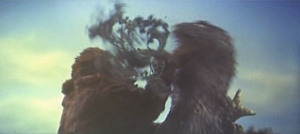
Given King Kong‘s one of the most successful and popular monster movies of all time, it’s enjoyed numerous revivals over the years. Including one in the early 1950s that directly inspired the American atomic monster craze and the daikaiju eiga of Japan. Kong‘s direct sequel, Son of Kong, and its kissing cousin, Mighty Joe Young were…less than successful.
But that didn’t stop special effects wizard Wells O’Brien from conceiving yet another sequel. Something that would retain all the grandiose power of the original but do away with that slapdash, chash-in feel that made Son of Kong suck. It would be a conscious throwback to that Golden Age of Monster Movies: the 1930s, the age of O’Brien’s primes. And it would climax in a gigantic fight scene in the streets of San Francisco, with Kong squaring off against a gigantic Frankenstein monster composed of animal parts and, presumably, a constantly-beating heart, irradiated by the atomic bombing of Hiroshima.
By 1960, O’Brien had a treatment all worked up, but the projected cost of the stop motion animation necessary to pull all this off made Hollywood skittish. The producer O’Brien hired, John Beck, began to shop the movie around overseas. He eventually wound up at Toho, who liked the idea of a giant Frankenstein so much they sat on it for three more years…after they made this.
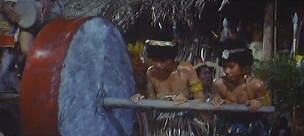
Which is also one of the most successful and popular monster movies of all time. And if you accidentally blunder into an argument over which film is better (this or the original Kong), God help you. ‘Cuz I sure as hell won’t. It’s another one of those movies even non-daikaiju fans have probably heard about. Might’ve even seen it in the bargain bins of Wal-Mart (or wherever the hell you “normal” people shop). Hell, they might’ve even watched it on TV, or have distant memories of some cloud-less globe, spinning in space, as a narrator droned Hamlet at them.
How big is this movie? King Kong vs. Godzilla boasts the biggest box office draw of any Godzilla movie to date (when adjusted for inflation) and remains one of the most popular for that reason alone, on top of all its other virtues. I’ve owned a copy of it since age five, when it became the first VHS tapes I ever wore out from overviewing. I’ve been over both the English and Japanese-language versions with instruments that make the starship Enterprise look like a bathsophere. I know this movie will always have a special place for it in my collection, no matter how many new media formats I have to buy.
So it’s with a sad heart that I report King Kong vs. Godzilla…doesn’t really work out all that well as a…ya know…movie. Now, now…put down your pitchforks. Let me explain, because the things holding it back as a movie are actually real simple. Unlike the plot, which is needlessly complicated.
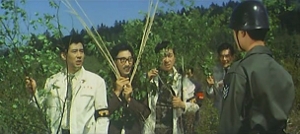
First, meet Mr. Tako (Ichirô Arishima), CEO and walking punchline of Pacific Pharmaceuticals. It’s the ’60s and Japan’s post-war economic wave is nowhere close to cresting (or so everyone thinks). Like so much else at the time, Pacific Pharma’s branching out. Thanks to the new consumer boom, a new medium’s called “television’s” suddenly become the in-thing. Everyone’s got one (and if they don’t, they’re less than human) so every Japanese corporation’s rushing to sponsor some TV show or four.
Problem is, Pacific-sponsored programs are all crap. The ratings reflect this, so Mr. Tako takes it out on his two TV point-men: Sakurai (Tadao Takashima) and Kinsaburo (Yû Fujiki), who will be our Bourgeois Heroes for the remainder of the film. Only the tall tales of a Pacific Pharmaceuticals company doctor save them from the unemployment line…by landing their asses in a 1930s monster movie.
The tales concern a legendary god-monster, worshiped by the natives of Faro Island, where the doctor’s recently discovered rare narcotic berry plant suitable for Pacific Pharma’s pharmacological purposes. Mr. Tako hears “monster” and in his mind he sees a publicity bonanza beyond the dreams of Orson Welles. You can see the vision force his eyeballs out of their sockets. He commands Our Heroes to
“Find me a monster, if he exists or not.”
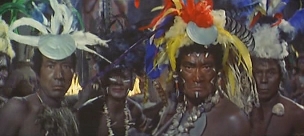
and the fact he has to stick a qualifier on there illustrates the almost-subliminal level of continuity in this series of Godzilla films. Obviously, this takes place a universe where monsters are real. In fact, everyone seems to accept them as commonplace parts of The Natural Order. The army tries to stop them, people evacuate from their path…but who cares? They’re like radioactive tornadoes. Everyone knows how things’ll end up, so they just go through the motions. As if the population of Japan’s learned to live with their monster-plagued reality…and they’ve accepted it rather well, considering.
Godzilla’s certainly real enough. As we see during brief cut-aways to the Arctic which interrupt all the boring, character introduction stuff most people ignore anyway. Since everyone recognizes Godzilla on sight, we can safely assume some version of the first two film’s events took place in this universe. Some suggest that’s why Godzilla begins the film frozen in an ice burg…except Raids Again ends with Godzilla buried under a landslide. It just happened to contain some ice. That be like me asphyxiating on volcanic gas at the climax of one adventure and then rising from a pit of lava at the beginning of the next.
But I won’t fault this third entry in the original Godzilla series for forgetting its own continuity. That’s an old trick, learned well by an entire generations of filmmakers raised on serialized action adventures before their main feature (lucky bastards – all I get are car commercials). Besides, if this were made today, we’d probably all call this movie a “soft reboot” of the franchise, anyway. It’s as if everyone recognized how much Raids Again sucked and the intervening seven years taught them to do the exact opposite of what they did in 1955.

I will fault Mr. Tako for his callous inhumanity, however, which the film plays for comedy because it didn’t think through his character and its unfortunate implications. After all, this is supposed to be a comedy, right? A comedy set in a world where, over the last almost-decade, giant monsters have besieged Japan nation on multiple occasion, causing untold loss of life and incalculable amounts of property damage. At least three major Japanese cities have been raised to their foundations…even though which three depends on which versions of these movies you’re watching.
Going by the originals, Tokyo’s suffered through three monster attacks all by its lonesome. And Mr. Tako thinks hauling another one home – for a publicity stunt, no less- will work out well? What an asshole. How could this be anything other than a disastrous idea? Besides, all Tako has to do is hire a special effects team and cut some cool commercials together. Eiji Tsuburaya could pull it off, no problem. That would be what a sane man might do. But Mr. Tako is nothing but a bad parody of a crappy boss stereotype, broad enough to transcend time and dumb enough to be more annoying everytime I see him. He’s like the human Batman Forever, completely ineffectual.
Which reminds me to note Step One in what I like to call The Versus Template, a set of rules which all future daikaiju productions would, in one way or another, derive from this film right here.
Introduce the main human cast and establish their mostly-pointless back stories as early as possible, in an ultimately-futile attempt to make the audience give a crap about them.

In this case, Sakurai is a Young Urban Professional, living high on the yuppie hog with his sister, Fumiko (Mie Hama, five years away from achieving international fame as Bond Girl Kissy Suzuki in You Only Live Twice). Fumiko’s going out with a sailor, Fujita (Honda Repertory Company vet Kenji Sahara, the man who beat back Rodan and the Mysterians), and Fujita’s brought home a sample of experimental wire that, he claims, is stronger than steel. He tests this out by dangling his full weight off the balcony, suspended by a wire no thicker than a guitar string. He also allows Tadao Takashima to make one of the best “Oh shit!” faces in the history of cinema.
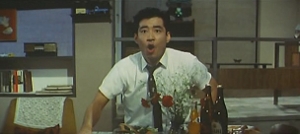
That’s nice and all, but Fujita might as well be wearing the tell-tale brown uniform from the Plot Point Delivery Service. Like Mr. Tako’s colander of an Evil Capitalist plot, this slice-of-life comedy is the first sign of the Godzilla’s series – and indeed, the whole daikaiju genre’s – shift towards a broader (but shallower) audience. Once they entered the demographic calculations of studio executives, post-War youngsters sent the average age of a Japanese theater attendee into a flat spin. Consequently, King Kong vs. Godzilla is a lighter film than anything in Toho’s catalog up to this point, and much more fantastical than the original King Kong. Hell, the Venture crew brought Kong’s full wrath down upon Skull’s Island natives. The Modern Imperialists of Mothra gunned down a squad of innocents in the process of kidnapping their god’s handmaidens.
Here, Sakurai and Kinsaburo basically row themselves ashore on Faro Island, guided by a sailor in a striped shirt and floppy hat who speak the local fakeguage (a combination of Chinese and Pigeon, I think). Our Heroes keep themselves from getting tossed into the sea by showing off the wonders of ham radio. But, in a scene that gets funnier every time I watch it, the two really seal the deal with the Chief by bribing him (and the entire village) with cigarettes.
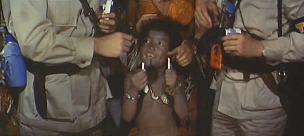
I used to laugh at the outrageous naivete of the past; at the scene itself, with its stealthy parody of Meet the Natives scenes in crappy adventure movies beyond count; or at the little kid, who I think is named Skittle. He just look so proud of his two new coffin nails. But these days, it mostly just reminds me of my time at college (that’s “university” for any English-speakers in my audience). Especially once the giant octopus attacks the village, providing the movie and Kong with an introductory action sequence. Godzilla’s little raid on an arctic base didn’t count, since it was pretty short and predictably one-sided. Let’s move to Step Two of The Versus Formula
The monster with the most continuity baggage must be introduced first. The human cast’s job then becomes either (a) reacting to this monster or (b) to their own petty lives. Either way, they should eventually go off somewhere to introduce the antagonist monster, or we’re never gonna get to the part we’re all really here for.
After busting through the token wall the Farroans have erected, Kong discovers the octopus is one of those damn psychic octopi, like the one that devoured Bella Legosi at the end of Bride of the Monster (spoiler alert). The kind that make you grab them and hold them to your head, or occasionally just beat yourself to death with their tentacles. Overcoming its psychic compulsions, Kong wins, and settles down to quench his thirst on some narcotic berry juice…which the natives manufacture in bulk, probably for just such an occasion. Kong falls asleep, and the assembled women of Faro Island conduct a little dance number. Like the one in Mothra, but better, because here all the actresses make sure to point their chests at the camera.
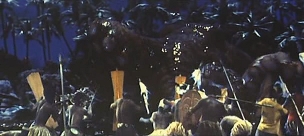
But wait…wasn’t this a Godzilla movie? Yes. But let’s take a moment to realize what you’ve just seen: a thirty minute remake of the original King Kong. Almost a parody of it, since Pacific Pharma’s boys are much more concerned with comedy than Carl Denham. That reading becomes almost unavoidable when you learn about the actors backgrounds in yuppie, workplace comedies, pretty much just like this first half of the film…minus the monsters.
Mr. Tako promptly flies out to Our Hero’s ship and inspects his prize. Meanwhile, Fumiko’s stuck back home while her may-on, Fujita, rides the Godzilla-infested high seas. Buried in second J of the local paper, she finds news that Fujita’s ship is lost and sets out for his port of call in a desperate effort to…be in the right place at the right time, so Godzilla can menace a character we kinda-sorta recognize and Kenji Sahara can save a damsel in distress. At this point, it was basically part of his contract: at least one per film. Preferably more (he saved Earth’s entire female population from an alien eugenics program last time), but certainly no less.
Back at sea, the Japanese government orders Kong returned to Faro, since they already have one daikaiju roaming the countryside. And besides, Mr. Tako forgot to file the correct paperwork. Kong picks this most narrative-inconvenient point to wake up and escape the flimsy-ass raft Our Heroes built to float him home. It’s time for Step Three
Monster Fight: Round 1. Which the “protagonist” monster (the one with all the backstory – in this case, Kong) is doomed to loose, leaving the antagonist monster free to rampage across the countryside.
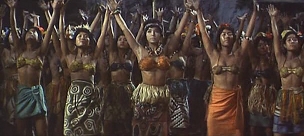
So, having had our King Kong remake, its time for the Ishiro Honda monster movie to get going. And it’s great stuff – but radically different from the rest of the film. That’s not a complaint. I welcome the absence of all that broad, workplace comedy masquerading as deft social satire. I can watch TV for that, and if I were a Japanese film-goer in the early 60s, I could’ve seen it in at least six other movies starring Tadao Takashima, Yû Fujiki and/or Ichirô Arishima.
By this point, the film’s abandon them in favor of General Shinzo (Jun Tazaki, on loan from the other movie Ishiro Honda made in 1962, Gorath) and his futile attempts to halt Godzilla’s second march on Tokyo, along with Dr. Shigezawa (Akihiko Hirata, playing his fourth Scientist in as many daikaiju films). The JDSF’s plan this time? Herd Godzilla into a gigantic tiger trap filled with explosives by filling rivers with gasoline and setting them on fire. It fails, but there’s a wonderful shot of Godzilla climbing out of the pit as anxious soldiers fall back. That’s King Kong vs. Godzilla in a nutshell: a nice idea, trapped in a movie that tossed logic to a giant octopus and cackled in glee as its pet chowed down.
So our Great Military Leader pins his hopes on the giant electric fence surrounding Tokyo. The fence Godzilla nuked with ease back in 1954…that works now…for some arbitrary reason. (Guess they just didn’t turn have the voltage back then…or something.) Godzilla retreats, leaving Kong to draw strength from the fence since – for equally arbitrary reasons (unless you remember this film began life as King Kong vs. Frankenstein) – electricity makes Kong stronger.

King Kong vs. Godzilla is a great title, but it’s a horrible movie concept. They had to make Kong over a hundred meters tall just to make it look like a fair fight. This Kong could pick up the T-rex his 1933 counterpart sparred with and snap it like a Slim Jim (oh yeah). What’s a little electromagnetic power compared to that? Just evens the odds. After all, Kong’s covered in hair and Godzilla can breath fire. You’d think the conclusion would be foregone.
Instead, Kong kills some time tromping through town before finding the one train in the entire city that happens to contain a character we kinda-sorta know: Our Chick, poor, poor Fumiko. Who winds up in Kong’s paw…for no reason, save that the film’s back in King Kong mode. And I have to wonder what god Fumiko pissed off. This is the second giant monster attack she’s lived through in a week. What the hell? Is Fumiko a potential Slayer? The actual Slayer didn’t face off against giant monsters this frequently. Or faint at the sight of them, for that matter.
At least this gives Our Yuppie Heroes, Sakurai, Fujita and Odious Comic Relief Kinsaburo, an excuse to meet up with the General and the Scientist before a bombardment of Kong accidentally kills Fumiko. Also, they have to initiate Step Four
The human cast must contrive some way to either kill to the antagonist monster outright or, failing that (as they have here), get the two monsters to kill each other. Either way, the monsters must meet up Monster Fight: Round Two at the beginning of Act Three. Standing in for the audience, the human characters will stand around observing this from Minimum Safe Distance.
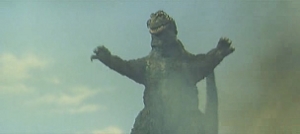
And that’s exactly what happens, since our Sitcom Heroes remember that plot point about the berry juice from early. General Shinzo weaponizes it, Our Heroes play a recording of that song the natives sang to Kong earlier, Kong passes out and Our Heroes use Fujita’s wire to airlift the big ape to Mt. Fuji…where Godzilla’s been standing around, checking his watch this whole time. That roar he gives Kong when he notices the military transport choppers hauling the great ape over the horizon means, Christ, it’s about fucking time. Thought they called ’em movies for a reason.
I was surprised to find this movie comes to us from the writer of Mothra, which I loved something fierce. I’m less surprised to find Shinichi Sekizawa also wrote the original version of Varan…which was never much more than a made-for-TV monster movie, even before the American distributors took their hatchets to it. That’s what King Kong vs. Godzilla feels like: a made-for-TV version of Honda’s mid-50s work. Right up until that final fight.
Which is 100% pure Bad Ass, don’t get me wrong. A running brawl that moves our combatants form the slops of Fuji to the sea. It’s got its own perfectly constructed internal narrative, sending Kong through the kind of silent Heroes Journey his original film didn’t have time for (since he only became the hero in post, after they added Max Steiner’s score atop his death scenes). You could remove it from the rest of the film and it would play perfectly well on its own.
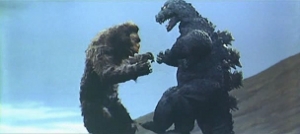
That’s my real problem, and the real bitch I intend to pitch on the doorstep of this film. They made a half-hour Godzilla film, a half-hour remake of Kong, and welded them together with a twenty minute fight scene. The result isn’t so much a movie as a Frankenstein monster. The mix is still off. The formula required further refinement. Making two monster films in one required an even larger cast than usual, dooming most of them to fight over the reduced screen time. Look at Poor Akihiko Hirata, still looking lost without his eyepatch and labcoat. He might as well be naked, and his Scientist contributes nothing aside from two ore three lines of exposition. Look at poor Fumi, menaced by both monsters. Hell, look at the whole flat, one-note, boring lot of them.
Most reviews don’t even mention them and that’s just sad. They’re all good actors with nothing to do but stand around, looking at things from Minimum Safe Distance. Most reviews focus on the monster combatants, who are a mixed bag in their own right.
Godzilla looks great – this is probably my favorite suit of the Showa series, combining the slim lines of the suit from Raids Again with a more crocodilian head, accentuating Godzilla’s reptilian menace. Kong got the short end of this stick. His suit looked threadbare and shaggy when this movie came out, and digital transfers have not helped him. They actually used two suits, plus the usual collection of puppets for the close-ups, and you can tell which is which by the lumpiness of Kong’s face, the presence or absence of pupils in his eyes, and/or the length of his arms, which from scene to scene, depending on whether Shôichi Hirose had to grab something.
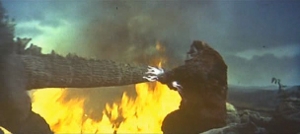
Like his fellow suitmation actor. Together with veteran Godzillas Haruo Nakajima and Katsumi Tezuka, Hirose helped define Giant Monster Rasslin’ for an entire generation of creatives and fans alike. It’s not hard to see why. Eiji Tsuburaya must’ve finally found and fired the guy who fucked up Raids Again‘s fight scene so poorly. Now that everything’s running at the correct film-speed, we can finally see just how much of a dirty fightin’ motherfucker Godzilla really was in this, his relative youth. Not only will he kick a guy who’s down, he’ll tailwhip the poor bastard. In the face.
So again, the question becomes How much is a 20 minute monster fight worth to you? Enough to sit through an hour and twenty-five minutes? Thankfully, fifty years worth of audiences have said Yes and King Kong vs. Godzilla was as successful a Frankenstein as any. This is the film most directly responsible for the rest of Godzilla’s films. For that alone, and for the sheer, cheesy fun of it, it’s required viewing despite the relatively-low rating…which I’m pretty sure most of you ignore anyway. In this case, you probably should.
![]()
![]()
![]()
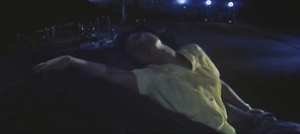

Thanks. great fun down here in the land of heat and humidity. But where were the airplanes? This film needed a few P51’s on loan from the Tuskegee Airmen with red tails to do close end machine gunnery on both monsters. Now that would be some thing to see.
That’s how you know no one really cared about making a King Kong movie. Once they hit the notes they felt they “needed” to hit, all contrivance is dropped and it ends on a big ol’ monster fight, cementing this film’s place as the most consistently popular of the series. A Godzilla fan might as well ask, “Where’s the overly-complicated relationship drama between the main cast?”
This monster movies is one of the best monster movies of all time and beyong amazing as well and classic that spawn other monster clashes as well and i am huge fan both godzilla,king kong .